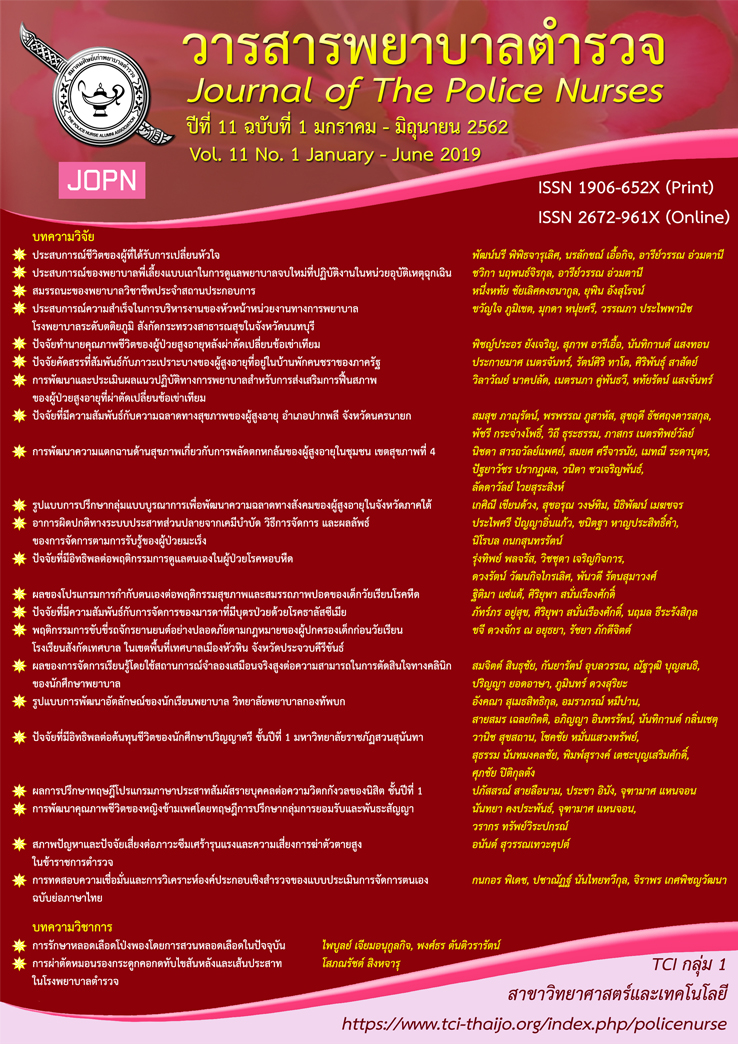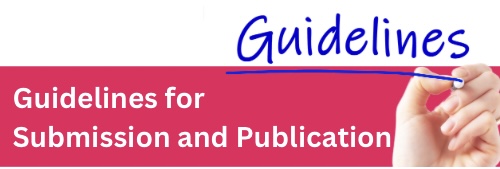MODEL OF NURSING STUDENT IDENTITY DEVELOPMENT, THE ROYAL THAI ARMY NURSING COLLEGE
Keywords:
model of nursing students identity developmentAbstract
The purpose of the research was to study the model of nursing student identity development in the Royal Thai Army Nursing College. The informants of this study, using purposive selection, were 17 persons involved in the educational management of the bachelor of nursing science of the Royal Thai Army Nursing College. The informants included former commanders, commanders of nursing instructors, nursing students, and alumnus of the said institution. The researcher utilized semi-structured interview in the data collection. Content analysis was used to analyze the interviewed data.
The royal Thai army nursing student’s identity development was focused on 3 sub-issues, which includes the following: 1) Personal identity which referred to the outstanding and different specific characters of general nurses; 2) Academic identity which referred to the knowledge of nursing science and military medicine; and 3) Professional identity which referred to the standard nursing competencies and the readiness of nursing performance in every situation. Furthermore, the model of nursing student identity development consisted of 5 elements as follows: 1) On the policy, curriculum and context, the Royal Thai Army aimed to produce nursing graduates who must present the desired identity that responded to the policy and mission of the military. The Royal Thai Army nurses have to be distinguished by specifying the desired competencies using good role models and adjusting appropriately according to the changing conditions; 2) On the input, the selection of the students who have proper qualification must be done. Nursing instructors and military officers serve as the role models by teaching and cultivating discipline, military personality and nursing professional spirit to the nursing students. 3) On the identity development process, specification of targeted competencies and behaviors which show the desired identity must be included in the curriculum design together with extracurricular activities. 4) On the facilitating factors to promote success and 5) Production, the involved persons must show their idea towards the model of nursing student identity development at an appropriately high level. Moreover, the possibility of using the model to develop the Royal Thai Army nursing student’s identity is also at an appropriately high level as well.
Downloads
References
Center for doctrine and strategy development, Army Training Command Department. (2012). Military government guide 1, Royal Thai Army. Bangkok.
Chaleoykitti, S., Bandansin, J., Kanglee, K., & Kumpraw, P. (2014). The study of academic services
integration with teaching and learning of general education for human development course on volunteer and happiness of study among 1st year nursing students of the Royal
Thai Army Nursing College. Journal of The Royal Thai Army Nurses, 15(3), 421-429.
Julawong, A. (2013). Nursing preparedness in the Royal Thai Army Nursing College. Journal of The Royal Thai Army Nurses, 14(1), 1-7.
Kaewjiboon, J., & Chairinkom, N. (2008). Research reported: The identity of Boromarajonani College of Nursing, Phayao. Boromarajonani College of Nursing, Phayao.
Khemapech, S. (2016). THE factors associated with motive achievement in police nursing students. Journal of the Police Nurses, 8(1), 116-124.
Macmillan, T. (1971). The Delphi technique. In the annual meeting of the California junior colleges associations committee on research and development May 3-5. California: Monterey.
Nawsuwan, K., Wisalaporn, S., & Sattayarak, W. D. (2015).Strategies to develop the nursing students’ identity in nursing colleges, ministry of public health. Hatyai Journal, 13(2), 117-132.
Paopong, S., Sirinapadol, J., Chansataporn, S., & Meesattayanan, P. (2011) The identity of nurses graduated from Boromarajonani College of Nursing, Nakhonratchasima. The Journal of Boromarajonani College of Nursing, Nakhonratchasima, 18(1), 5-16.
Sanitsom, P., & Jarat, N. (2015). Military leadership attributes for Royal Thai Armed Force. Executive Journal, 35(1), 75-86.
Siripukdeekan, A., & Wiserith, W. (2014). A study of disaster nursing management. Journal of The Royal Thai Army Nurses, 15(2), 348-359.
Srikanok, W. (2013). The development of competency framework of the Royal Thai Army Nursing College’s personnel. Journal of The Royal Thai Army Nurses, 14(3), 151-158.
Srisuphan, W., Laungamornlert, S., & Sawaengdee, K. (2012). Preparation of the nursing profession into ASEAN community. Thai Journal of Nursing Council, 27(3), 5-10.
Suksaen, N. (2016). Military characteristics of air force student nurses according to parent’s opinions in Royal Thai Air Force Nursing College, academic year 2016. Journal of The Royal Thai Army Nurses, 18(2), 159-167.
Yingdumnun, V. (2011). A study of the achievement of the public mind project: A case study of secondary school students of BANGMOD wittaya school “Seesukwadjuan Uppathum”
(thesis for the degree of master of arts (Buddhist Studies). Graduate school, Mahachulalongkornnrajavidyalaya university Bangkok, Thailand.
Zainalipour, H., Zarei, E., & Dayeripour, F. (2011). Study of individual factors Influencing on academic achievement motivation in high-school female students. Journal of Educational and Management Studies, 2(2), 43-47.
Downloads
Published
How to Cite
Issue
Section
License
ผลงานที่ได้ตีพิมพ์แล้วจะเป็นลิขสิทธิ์ของวารสารพยาบาลตำรวจ














